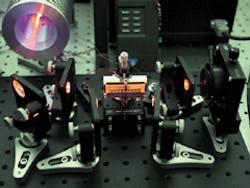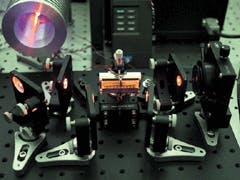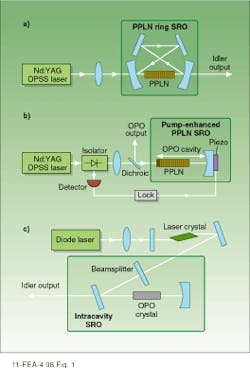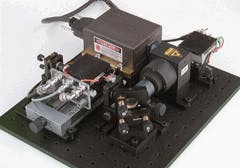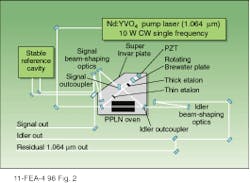OPOs tune solid-state CW lasers from 3 to 5 microns
OPOs tune solid-state CW lasers from 3 to 5 microns
Singly resonant cavity designs extend applications in remote sensing and materials processing.
Finlay G. Colville and Brendan T. McGuckin
Solid-state continuous-wave (CW) lasers tunable from 3 to 5 µm increasingly are replacing lead-salt diode, gas, and deuterium-fluoride lasers in applications such as remote sensing of environmentally sensitive gases or interferometric measurement of wavefront distortion. Fueling this takeover are recent advances in CW diode-pumped solid-state (DPSS) lasers, periodically poled materials, and optical parametric oscillators (OPOs).
Output power enhancement is key. While solid-state sources based on difference-frequency mixing and tunable infrared diode lasers will work as mobile trace-gas detection devices for process control, the sources are limited to low power levels. Combined with OPOs, CW DPSS lasers not only allow continuous tuning of wavelengths within a broad spectral range, they also provide power scaling.
Another application in which high CW output power is critical is materials processing in the mid-infrared range, where there can be problems related to the Fresnel losses from the optical surfaces of the high-index work materials. The CW DPSS technology also may enhance defense applications related to sensor dazzle and electro-optics counter-operations or protection measures.
Fine-tuning the wavelength
An optical parametric oscillator is an optically pumped nonlinear device. When pumped with a short-wavelength beam at frequency np, it generates two outputs--the signal and the idler--at frequencies ns and ni, respectively, where np= ns+ ni. Varying the phase-matching properties either by temperature or by angular adjustments allows tuning both signal and idler outputs to specific wavelengths. An OPO, for instance, can shift the fixed-wavelength output from a near-infrared DPSS laser to idler wavelengths of 3 to 5 µm.
Until recently, the intensity dependence of nonlinear frequency-conversion limited solid-state-laser-based OPOs to high-energy Q-switched operation. Although the first CW OPO was demonstrated some 30 years ago, the early CW devices were characterized by erratic amplitude and frequency instabilities owing to the absence of stable pump sources and robust nonlinear materials.1 Although some devices achieved pump thresholds below 100 mW, both the signal and the idler were resonant in their cavity designs. Maintaining the double resonance required the pump laser to operate in a single-axial mode with megahertz stability and the OPO cavity length to be stable to several nanometers.
Reaching the elusive goal of stable CW OPO operation required singly resonant devices, and their relaxed-frequency constraints came at the expense of high-pump-power requirements. Even in the early 1990s, required pump power (10 to 100 W) still limited singly resonant devices to the research laboratory. This hunger for pump power began to wane only after advances were made in high-power CW DPSS lasers and CW OPO resonator designs.
The conventional singly resonant OPO design, for example, locates the OPO externally to the pump source so that the device resonates only at the signal and not at the pump or idler wavelengths. In 1993, researchers at Stanford University (Palo Alto, CA) demonstrated the first CW singly resonant OPO when they double-passed both the pump and nonresonant idler fields back through a potassium titanyl phosphide (KTP) crystal. This reduced the pump threshold of the device to 1.4 W.2
In an alternative approach developed at the University of St. Andrews (Fife, Scotland), the singly resonant OPO is resonant at both the pump and signal.3 The extracavity configuration is the pump-enhanced device--the dynamics of which are analogous to extracavity, pump-enhanced, second-harmonic generation. Enhancing the laser within an external cavity introduces a new set of requirements, however, such as a single-frequency pump source and sophisticated electronics to stabilize both the laser frequency and the OPO cavity length.
Collectively, the Stanford and St. Andrews efforts prompted the commercial development of CW OPOs. Researchers then targeted the demand for tunable CW DPSS lasers in the mid-infrared.
Into the infrared
Adding to breakthroughs in cavity design have been developments such as the power scaling of CW DPSS lasers as pump sources and the emergence of materials with transparency ranges extending into the mid-infrared. High-quality nonlinear materials, for instance, can now phase-match the output of neodymium-based lasers to provide idler output in the 3 to 5-µm region. Examples include potassium titanyl arsenate (KTA) and periodically poled lithium niobate (PPLN).
Three distinct approaches are emerging as candidates for a new generation of practical CW singly resonant OPOs based on DPSS lasers (see Fig. 1). The first is a multiple-watt CW laser pumping an extra-cavity PPLN singly resonant OPO within a four-mirror ring cavity.4 In the system developed at Lightwave Electronics (Mountain View, CA) and Stanford University, the high nonlinearity of PPLN decreases pump requirements of singly resonant devices to modest levels--thresholds of 2 to 4 W, efficiencies exceeding 90%, and idler wavelengths of 2.3 to 4.7 µm.
In a related development, Aculight Corp. (Bothel, WA) has reported high-power operation of CW extracavity PPLN singly resonant OPOs.5 Pumped with 23 W from a flashlamp-pumped Nd:YAG laser, the firm`s ring-cavity PPLN device generates 5.1 W at 3.4 µm (see photo on p. 83).
Sandia National Laboratories (Livermore, CA) also is exploring PPLN-based ring-cavity singly resonant OPOs in remote-sensing and spectroscopic applications. Some of the research is a collaboration with Laser Imaging Systems (Punta Gorda, FL) under contract from the Department of Energy and the Gas Research Institute (Chicago, IL).
The second design approach--an adaptation of the St. Andrews pump-enhanced technique--produces a compact CW PPLN singly resonant OPO with output of 2.3 to 4 µm.6 Developed at the University of Konstanz (Germany), the device features low-threshold (140 mW), single-frequency, mode-hop-free operation with high stability (<30 MHz/h) and narrow linewidth (<160 kHz; see Fig. 2). The laboratory device has performed photoacoustic trace-gas detection of ethane at 3.4 µm, with sensitivity below the parts-per-billion level.
The third approach, a novel alternative to the above methods, is an intracavity CW oscillator with the singly resonant OPO inside the laser.7 Also developed at St. Andrews, the device can access the very high circulating powers within the pump laser. Another advantage over extracavity singly resonant OPOs relates to the robust birefringently phase-matched materials used, such as KTA, and their high damage thresholds and low temperature sensitivities. The intracavity approach allowed the US Air Force Research Laboratories (Wright Patterson Air Force Base, OH) and the University of Dayton (Dayton, OH) to develop PPLN intracavity OPOs as low-threshold sources for infrared countermeasures (see Laser Focus World, Aug. 1997, p. 17).
Beyond the lab
Perhaps the first "commercial" CW OPOs are separate devices from Coherent Inc. (Santa Clara, CA) and Tunable Laser Technology Ltd., a technology-transfer initiative between Edinburgh Instruments Ltd. and the University of St. Andrews. The first Tunable Laser Technology product, the OPOtune-3.5--based on an exclusive license from the UK-based Defence Evaluation Research Agency (Malvern, England)--is based on a CW DPSS neo dymium-doped vanadate (Nd:YVO4) laser and an intracavity KTA singly resonant OPO (see Fig. 3).
Coherent adapted an infrared version of its Verdi laser as the pump source for an extracavity PPLN CW singly resonant OPO. Its goal is single- frequency scanning in the mid-infrared to complement the firm`s Ti:sapphire and dye-ring lasers for high-resolution spectroscopy. Last year, a proof-of- concept system demonstrated 700 mW of single-frequency signal and idler output (see Fig. 4). Coherent`s target specifications include a continuous-scanning range of 60 GHz with a linewidth below 1 MHz. o
REFERENCES
1. R. G. Smith et al., Appl. Phys. Lett. 12, 308 (1968).
2. S. T. Yang et al., Opt. Lett. 18, 971 (1993).
3. G. Robertson et al., Opt. Lett. 19, 1735 (1994).
4. W. R. Bosenberg et al., Opt. Lett. 21, 713 (1996).
5. S. C. Tidwell et al., OSA CLEO post-deadline CPD25-2 (1997).
6. K. Schneider et al., Opt. Lett. 22, 1293 (1997).
7. F. G. Colville et al., Opt. Lett. 22, 75 (1997).
Experimental arrangement of an Aculight extracavity continuous-wave device locates a 50-mm-long periodically poled lithium niobate crystal within a four-mirror bow-tie ring cavity.
FIGURE 1. Continuous-wave (CW) singly resonant OPO (SRO) designs include a multiwatt CW laser pumping an extracavity PPLN SRO comprised of a four-mirror ring (a), a pump-resonant semimonolithic SRO (b), and an intracavity device in which the SRO is located internal to the pump to exploit circulating powers (c).
FIGURE 2. Single-frequency periodically poled lithium niobate singly resonant OPO with narrow linewidth was developed at the University of Konstanz.
FIGURE 3. Compact DPSS laser-based prototype CW SRO provides 1 W output at 3.5 µm.
FIGURE 4. Prototype singly resonant OPO from Coherent is an extracavity periodically poled lithium niobate design.
FINLAY G. COLVILLE is a director of Tunable Laser Technology Ltd., Edinburgh, Scotland; e-mail: [email protected]. BRENDAN T. MCGUCKIN is the divisional manager of electro-optics at Edinburgh Instruments Ltd., Riccarton, Currie, Edinburgh EH 14 4AD, Scotland; e-mail: [email protected].
